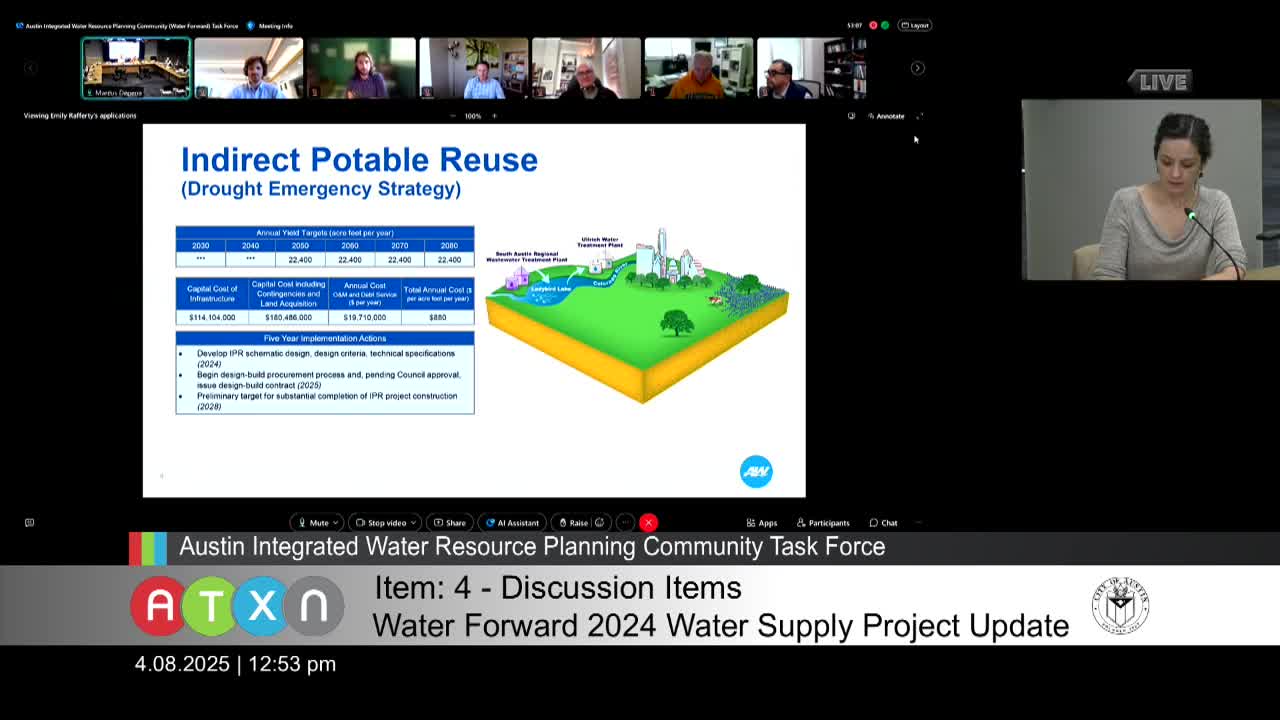Austin plans indirect potable reuse project via Lady Bird Lake and Lake Walter E. Long
April 08, 2025 | Austin, Travis County, Texas
This article was created by AI summarizing key points discussed. AI makes mistakes, so for full details and context, please refer to the video of the full meeting. Please report any errors so we can fix them. Report an error »

The Austin Integrated Water Resource Planning Community Task Force convened on April 8, 2025, to discuss critical strategies for enhancing the city's water supply through indirect potable reuse and the utilization of Lake Walter E. Long as a supply reservoir. The meeting focused on two primary strategies aimed at addressing Austin's growing water demands and ensuring sustainable water management.
The first strategy discussed was indirect potable reuse (IPR), which involves treating wastewater effluent from the South Austin Regional Wastewater Treatment Plant. This treated water would be discharged into Lady Bird Lake, specifically upstream of Longhorn Dam, and subsequently withdrawn from a new intake and pump station downstream of Tom Miller Dam. The plan anticipates the withdrawal of up to 22,400 acre-feet of water annually, which would then be treated to potable quality at the Ulrich Water Treatment Plant. Initial modeling indicates that the treated water may not fully reach the intake point, but it remains within the same lake system.
The second strategy involves diverting water from the Colorado River to Lake Walter E. Long, utilizing existing water rights and contracts. This approach would require the construction of a new water treatment plant capable of processing 20 million gallons per day, employing advanced treatment technologies. The diversion point is strategically located downstream of the Walnut Wastewater Treatment Plant, allowing for the effective use of treated effluent. The task force emphasized the importance of integrating this strategy with existing plans for a smaller water treatment facility on the East Side of Austin.
Throughout the discussions, task force members raised questions regarding the operational logistics of these strategies, including the coordination required with the Lower Colorado River Authority (LCRA) to manage water levels and environmental flow requirements. The potential impacts on recreational use of Lake Walter E. Long were also considered, with assurances that improvements would be made to maintain access for recreational users.
The meeting concluded with a recognition of the significant costs associated with the Lake Walter E. Long strategy, which is estimated to be approximately two and a half times more expensive than the IPR approach. The task force plans to continue evaluating both strategies to determine the most effective means of securing Austin's water supply in the face of increasing demand and potential drought conditions. Further assessments, including water quality sampling and hydrological modeling, are expected to inform future decisions.
The first strategy discussed was indirect potable reuse (IPR), which involves treating wastewater effluent from the South Austin Regional Wastewater Treatment Plant. This treated water would be discharged into Lady Bird Lake, specifically upstream of Longhorn Dam, and subsequently withdrawn from a new intake and pump station downstream of Tom Miller Dam. The plan anticipates the withdrawal of up to 22,400 acre-feet of water annually, which would then be treated to potable quality at the Ulrich Water Treatment Plant. Initial modeling indicates that the treated water may not fully reach the intake point, but it remains within the same lake system.
The second strategy involves diverting water from the Colorado River to Lake Walter E. Long, utilizing existing water rights and contracts. This approach would require the construction of a new water treatment plant capable of processing 20 million gallons per day, employing advanced treatment technologies. The diversion point is strategically located downstream of the Walnut Wastewater Treatment Plant, allowing for the effective use of treated effluent. The task force emphasized the importance of integrating this strategy with existing plans for a smaller water treatment facility on the East Side of Austin.
Throughout the discussions, task force members raised questions regarding the operational logistics of these strategies, including the coordination required with the Lower Colorado River Authority (LCRA) to manage water levels and environmental flow requirements. The potential impacts on recreational use of Lake Walter E. Long were also considered, with assurances that improvements would be made to maintain access for recreational users.
The meeting concluded with a recognition of the significant costs associated with the Lake Walter E. Long strategy, which is estimated to be approximately two and a half times more expensive than the IPR approach. The task force plans to continue evaluating both strategies to determine the most effective means of securing Austin's water supply in the face of increasing demand and potential drought conditions. Further assessments, including water quality sampling and hydrological modeling, are expected to inform future decisions.
View full meeting
This article is based on a recent meeting—watch the full video and explore the complete transcript for deeper insights into the discussion.
View full meeting
